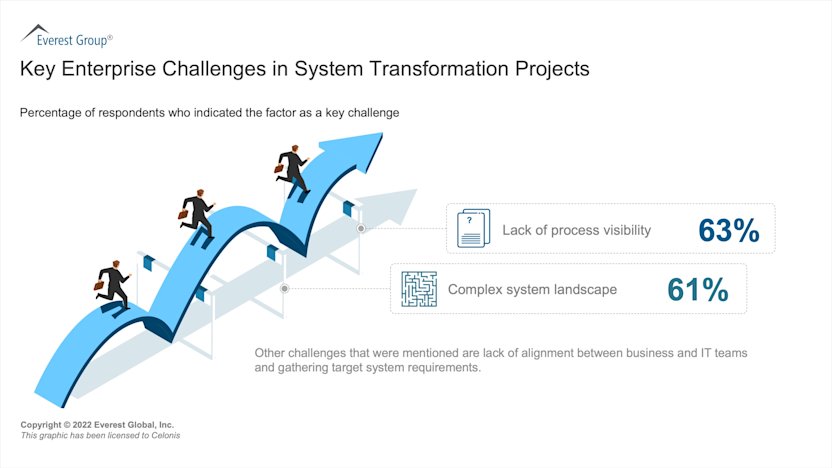
The Importance of Process Optimization in System Transformation
We are pleased to share this blog from Everest Group authors, Amardeep Modi, Harpreet Makan, and Santhosh Kumar.
Compelled by the digital revolution, organizations of all sizes and in every industry are embracing modern technologies and driving digital transformation as a strategic agenda. With digital transformation becoming a key to sustaining business in today’s financially uncertain and competitive landscape, system transformation provides a foundation for enterprises to build a digital-first business. Read on to learn the benefits and best practices for implementing system transformation.
The full Everest Group report, The Importance of Process Optimization in System Transformation, is available to download for free.
Understanding system transformation and its role in enterprise digital transformation
System transformation involves implementing the most relevant modern systems/software in an optimized manner to achieve enterprises’ modernization objectives. Enterprises undertake system transformation for several reasons, including improved ability to meet customer expectations in a digital-first world, enhanced security, seamless digital experiences for employees, and improved business resilience and agility.
Today, business and IT teams collaborate to decide on the type of system transformation projects they should embark on based on their existing system landscapes, strategic priorities, and future demands. The key types of projects include:
Application consolidation – involves consolidation or reorganization of all the existing systems across the organization, typically based on a systems usage analysis
Greenfield implementation – involves the design, installation, and configuration of new systems from scratch
Brownfield implementation – refers to the upgrade or modernization of existing legacy systems/infrastructure; it does not involve complete reconstruction
Hybrid implementation – refers to a combined implementation of net-new systems (greenfield) and an upgrade of existing systems (brownfield)
Regardless of the approach, enterprises that decide to undertake system transformation are faced with several challenges in executing these projects. Let’s explore the obstacles that enterprises need to overcome.

Notably, 63% of the enterprises indicated a lack of process visibility as a key challenge. This can be attributed to organizations’ heavy reliance on manual techniques to understand processes. Such techniques are highly ineffective in accurately representing as-is processes and identifying ways to improve them.
The need for process optimization
Performing process optimization as a part of system transformation projects enables near real-time process visibility and helps maintain accurate process documentation. Mature organizations have indicated their focus on technology-driven process optimization, which involves analyzing process data to discover and document baseline processes and reengineer existing processes.
An Everest Group survey found that mature enterprises that have embedded process optimization in their system transformation projects have achieved a significantly greater impact than other enterprises on both outcome and effectiveness metrics. Now let’s take a more in-depth look at the findings:
On average, enterprises that have focused on process optimization before they started a system transformation have achieved more than two times Return on Investment (ROI) than other enterprises from system transformation projects.

Source, Everest Group
A strong focus on process optimization as part of system transformation projects is a key differentiator for mature enterprises that have helped them realize superior value.
Benefits of implementing process optimization
Mature enterprises indicate that conducting system transformation with a focus on process optimization has helped them achieve superior business benefits, including:
Strategic impact – sustainable operations, business continuity and agility, better RoI from system transformation, higher customer satisfaction, and better employee experience
Operational impact – higher operational efficiency, shorter turnaround time, and better process governance
Cost impact – lower operational costs and reduced technical debt
The primary goal of conducting process optimization in system transformation is to enable a digital-first business with not only the most relevant and modern systems but also lean, resilient, and agile business operations. Scaled technology adoption is also helping enterprises overcome the limitations of manual techniques for process optimization.
The role of technology in driving data-driven process optimization
Technologies such as process mining, automation, and process orchestration can add significant value to traditional process analysis and optimization techniques, which rely solely on process owners’ knowledge and experience in discovering and improving processes. A technology-driven fact-based approach, with limited reliance on human bias and opinions, is easier to scale and provides greater depth and breadth of information, thereby facilitating operational transparency.
Over 50% of mature enterprises indicated that they leverage process mining as a key technology to drive process optimization.
Process mining solutions capture process-related information from event logs generated by enterprise systems, such as Enterprise Resource Planning (ERP), Customer Relationship Management (CRM), and Supply Chain Management (SCM), to discover and analyze as-is processes; process mining is primarily carried out at a macro level.

Source, Everest Group
Process mining plays a significant role in helping enterprises achieve the desired benefits from their process optimization efforts.
Challenges in the journey and best practices to drive process optimization
Enterprises that carry out process optimization in system transformation projects face multiple challenges including:
Lack of leadership support to expand the scope of the system transformation project and include process optimization
Difficulty in sourcing the skills required to execute the process optimization initiative
Lack of a strategy to balance business and IT objectives
Limited collaboration between process owners and the IT team
Heavy reliance on manual techniques for process optimization
To successfully implement system transformation and maximize the benefits from their investments, enterprises should:
Secure crucial leadership buy-in and sponsorship
Collaborate actively with process owners to ensure success
Understand end-to-end processes to carry out process optimization meaningfully
Select the right technologies, such as process mining, task mining, and Robotic Process Automation (RPA), which enable a fact-based approach to manage end-to-end processes
Institute a change management program that involves relevant stakeholders and process Subject Matter Experts (SMEs) for inputs and regular feedback
With modern systems as a foundational element of a digital-first organization, system transformation is a key enabler of digital transformation offering great promise. Most enterprises today are barely scratching the surface of this opportunity. Focusing on technology-driven process optimization and embedding it into the organization’s system transformation strategy can help enterprises unlock exponential value and benefits.
Get the free Everest Group reportAbout the authors
Amardeep Modi is a Vice President with Everest Group. Harpreet Makan is a Practice Director with Everest Group. Santhosh Kumar is a Senior Analyst with Everest Group.



